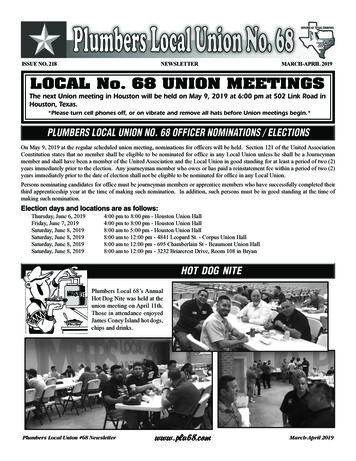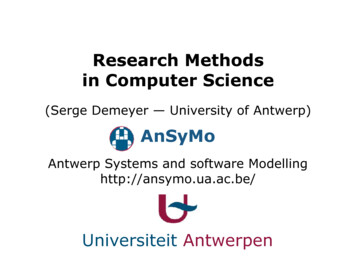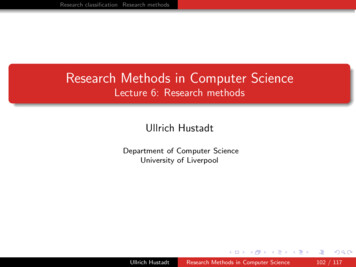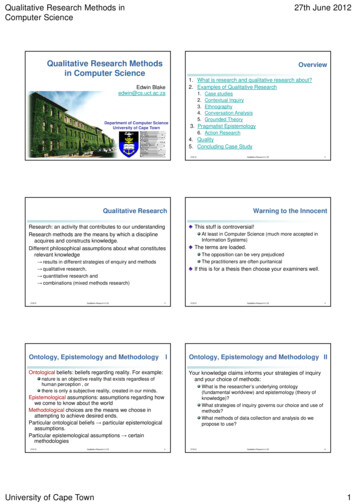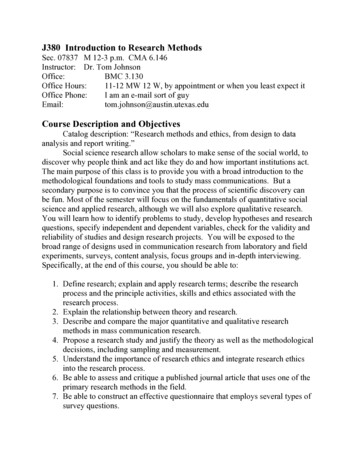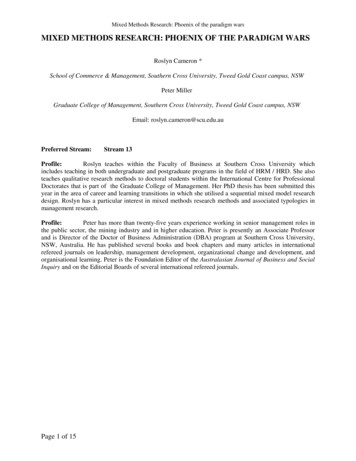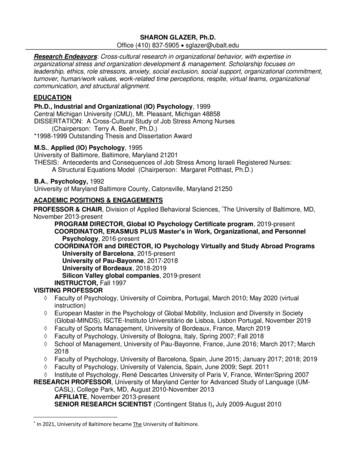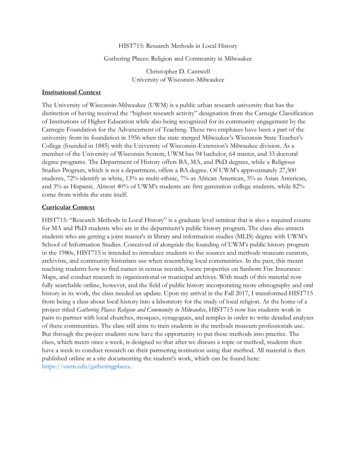
Transcription
HIST715: Research Methods in Local HistoryGathering Places: Religion and Community in MilwaukeeChristopher D. CantwellUniversity of Wisconsin-MilwaukeeInstitutional ContextThe University of Wisconsin-Milwaukee (UWM) is a public urban research university that has thedistinction of having received the “highest research activity” designation from the Carnegie Classificationof Institutions of Higher Education while also being recognized for its community engagement by theCarnegie Foundation for the Advancement of Teaching. These two emphases have been a part of theuniversity from its foundation in 1956 when the state merged Milwaukee’s Wisconsin State Teacher’sCollege (founded in 1885) with the University of Wisconsin-Extension's Milwaukee division. As amember of the University of Wisconsin System, UWM has 94 bachelor, 64 master, and 33 doctoraldegree programs. The Department of History offers BA, MA, and PhD degrees, while a ReligiousStudies Program, which is not a department, offers a BA degree. Of UWM’s approximately 27,500students, 72% identify as white, 13% as multi-ethnic, 7% as African American, 5% as Asian American,and 3% as Hispanic. Almost 40% of UWM’s students are first generation college students, while 82%come from within the state itself.Curricular ContextHIST715: “Research Methods in Local History” is a graduate level seminar that is also a required coursefor MA and PhD students who are in the department’s public history program. The class also attractsstudents who are getting a joint master's in library and information studies (MLIS) degree with UWM’sSchool of Information Studies. Conceived of alongside the founding of UWM’s public history programin the 1980s, HIST715 is intended to introduce students to the sources and methods museum curators,archivists, and community historians use when researching local communities. In the past, this meantteaching students how to find names in census records, locate properties on Sanborn Fire InsuranceMaps, and conduct research in organizational or municipal archives. With much of this material nowfully searchable online, however, and the field of public history incorporating more ethnography and oralhistory in its work, the class needed an update. Upon my arrival in the Fall 2017, I transformed HIST715from being a class about local history into a laboratory for the study of local religion. As the home of aproject titled Gathering Places: Religion and Community in Milwaukee, HIST715 now has students work inpairs to partner with local churches, mosques, synagogues, and temples in order to write detailed analysesof these communities. The class still aims to train students in the methods museum professionals use.But through the project students now have the opportunity to put these methods into practice. Theclass, which meets once a week, is designed so that after we discuss a topic or method, students thenhave a week to conduct research on their partnering institution using that method. All material is thenpublished online at a site documenting the student’s work, which can be found here:https://uwm.edu/gatheringplaces.
Research Methods in Local HistoryHIST 715 Spring 2019Temple Emanu-El. UWM Archives.Christopher D. Cantwell, Ph.D.326 Holton Hall Office Hours: Thurs 2-4pmcantwelc@uwm.eduCourse Description:Local history, like public history, is peculiar among other fields of historical inquiry in that its central focusis not topical. After all, one could do local labor history, local women’s history, local business history, and,as we will, local religious history. Rather, what sets local history apart from other parts of the historicalprofession is a set of professional and ethical concerns. Who is local history for? And where does one go tofind it? How does a historian work with the community they study when members of that community maybe a neighbor as much as objects of study? What can local history do? And how can historians build thekind of relationships that not only yield obscure or overlooked sources, but also ensures their work hasimpact?We will try and work through all of these questions throughout the course of this semester. Rather thanconsider local history from a conceptual standpoint, we will actually do the work of local history bylaunching a new project focused on the history of Milwaukee’s churches, mosques, synagogues, temples,and other houses of worship. Throughout this semester, each of you will work with a religious communityin Milwaukee to write its history. The process will involve archival research, one-on-one interviews, andethnographic analysis. These histories will then be published online to create a living resource ofMilwaukee’s religious diversity.1
Course Requirements and Grading:Your final grade requires you to participate in all of the requirements below. Participation (25%): Knowledge is never passively received, but always activelyconstructed. Therefore, a portion of your grade comes from the best way for you to learn: byengaging with the course materials and your colleagues. “Participation” covers every aspect of yourinvolvement in the course including attendance, attentiveness, discussion, and the completion ofrequired assignments. The course will ultimately be more beneficial, and more interesting, if youengage it seriously. This also extends to class attendance. Any unexcused absence from class willresult in a deduction of your participation grade.Miscellaneous Assignments (10%): In addition to the major assignments listed below, you will see anumber of other assignment-like activities listed in the schedule below. A fifth of your grade willcome from successful completing these miscellaneous tasks, which are: 1) the reflection paper onlocal history, 2) the reflection paper on places of worship, and 3) the architectural profile of yourplace of worship.Spatial Biography (10%): To help you learn the software we will be using for the final project, youwill be doing a map-based biography of either yourself or some historical figure. More info to come.PoW Report (10%): In the run up to writing the history of your congregation, you will write up abrief “Place of Worship (PoW) Report” that outlines all of the major facts about thecongregation(s) you are studying. More details to come.Oral History Interview (10%): As part of your research into the history and present of Milwaukee’shouses of worship, you will conduct at least one oral history that is approximately 40 minutes inlength. More details will follow.Field Recording (10%): As we will discuss, the study of religion is about more than just the study ofbeliefs and practices. It is also about the sites, smells, and sounds of a community. As such, ourclass is partnering with the American Religious Sounds Project to advance this goal. So ten percent ofyour grade will come from recording a religious sound and uploading it to the ARSP’s website.More details to come.Final Project (25%): Your final project will be a substantive history of a particular place of worship,which will be uploaded onto a map-based digital exhibit. It will include portions of all of theassignments we’ve gone through throughout the semester.Late work will not be accepted unless you first consult with me—but do consult with me if you need anextension.Required Texts:The following texts are available for purchase through UWM eCampus.Day, Katie. Faith on the Avenue: Religion on a City Street. New York: Oxford University Press, 2014. ISBN:978-0199860029.McMahon, Eileen. What Parish are You From? A Chicago Irish Community and Race Relations. Lexington:University of Kentucky Press, 1996.Wind, James P. Places of Worship: Exploring Their History. New York: Routledge, 1995. ISBN: 9780761989783.2
In addition to these required texts there are a number of readings that will be available either online orthrough D2L.University Resources and Policies: Students with disabilities. Notice to these students should appear prominently in the syllabus sothat special accommodations are provided in a timely manner. http://uwm.edu/arc/ Religious observances. Accommodations for absences due to religious observance should benoted. http://www4.uwm.edu/secu/docs/other/S1.5.htm Students called to active military duty. Accommodations for absences due to call-up of reserves toactive military duty should be noted.o Students: http://uwm.edu/active-duty-military/o Employees: ops/bn9.pdf Incompletes. A notation of "incomplete" may be given in lieu of a final grade to a student who hascarried a subject successfully until the end of a semester but who, because of illness or otherunusual and substantiated cause beyond the student's control, has been unable to take or completethe final examination or to complete some limited amount of termwork. https://www4.uwm.edu/secu/docs/other/S 31 INCOMPLETE GRADES.pdf Discriminatory conduct (such as sexual harassment). Discriminatory conduct will not be toleratedby the University. It poisons the work and learning environment of the University and threatensthe careers, educational experience, and well-being of students, faculty, andstaff. https://www4.uwm.edu/secu/docs/other/S 47 Discrimina duct Policy.pdf Academic misconduct. Cheating on exams or plagiarism are violations of the academic honor codeand carry severe sanctions, including failing a course or even suspension or dismissal from theUniversity. es/academic-misconduct/ Complaint procedures. Students may direct complaints to the head of the academic unit ordepartment in which the complaint occurs. If the complaint allegedly violates a specific universitypolicy, it may be directed to the head of the department or academic unit in which the complaintoccurred or to the appropriate university office responsible for enforcing thepolicy. https://www4.uwm.edu/secu/docs/other/S 47 Discrimina duct Policy.pdf Grade appeal procedures. A student may appeal a grade on the grounds that it is based on acapricious or arbitrary decision of the course instructor. Such an appeal shall follow the establishedprocedures adopted by the department, college, or school in which the course resides or in the caseof graduate students, the Graduate School. These procedures are available in writing from therespective department chairperson or the Academic Dean of theCollege/School. http://www4.uwm.edu/secu/docs/other/S28.htm LGBT resources. Faculty and staff can find resources to support inclusivity of students whoidentify as LGBT in the learning environment. http://uwm.edu/lgbtrc/ Other. The final exam requirement, the final exam date requirement,etc. http://www4.uwm.edu/secu/docs/other/S22.htm3
SCHEDULE(subject to change)Readings marked with a “*” are available on D2L.Date1/28ReadingsIntroductions2/4What is Local History? (Please read in the order given.)Read: AssignmentDue:Write a 500 word reflection paper onlocal history. Does reading these inchronological order present theJames S. Buck, Pioneer History of Milwaukee (Milwaukee: Swain & Tate, 1890), I:development of any kind of“Explanatory,” “Author’s Preface,” and “Introduction.”historiography? Can you f01buck#page/n5/mode/2up.differing schools of thought? If so,Joseph K Hart, ed., Educational Resources of Village and Rural Communities (New York:what are the stakes between these waysMacmillan Company, 1913), 83-87.of studying history at the local 0hart#page/82/mode/2up.What school of thought would youDonald Dean Parker, Local History: How to Gather It, Write It, and Publish It (New York:place yourself in? And why? Finally, trySocial Science Research Council, 1944), xi-xiv.https://babel.hathitrust.org/cgi/pt?id mdp.39015003459834;view 2up;seq 6;size 125 to come up with your own definitionof what is—and what is the purpose* John Bodnar, Remaking America: Public Memory, Commemoration, and Patriotism in theof—local history.Twentieth Century (Princeton, NJ: Princeton University Press, 1992), 111-166.* Shelton Stromquist, “A Sense of Place: A Historian Advocates ConceptualApproaches to Community History,” History News (April, 1983): 17-20.* Michael Frisch, A Shared Authority: Essays on the Craft and Meaning of Oral and PublicHistory (Albany: State University of New York Press, 1990), xv-xxiv.Helen M. Lewis, “Community History,” OAH Magazine of History 11:3 (1997): 20-22.http://www.jstor.org/stable/25163147.Katrine Barber, “Shared Authority in the Context of Tribal Sovereignty,” The PublicHistorian 35:4 (2013): ontent/35/4/2. [Must be on UWM’sNetwork to read.]* Christopher D. Cantwell, “Gathering Places: Religion and Community inMilwaukee,” Wisconsin Humanities Council Interpretive Grant application, 2017.4
2/11What is a Place of Worship (PoW)?MEET: Meet at the Jewish Museum of Milwaukee, 1360 N Prospect Ave, Milwaukee, WI53202.Special Guest: Ellie Gettinger, Director of Education, JMM.Read: 2/18John G. Gregory and Rees E. Powell, First Methodist Episcopal Church, Milwaukee(Milwaukee: First Methodist Church, 1936). Skim to get a sense of its 29.* E. Brooks Holifield, “Toward a History of American Congregations,” in AmericanCongregations, Vol. 2 New Perspectives in the Study of Congregations, James P. Wind andJames W. Lewis, eds. (Chicago: University of Chicago Press, 1994), 23-53.* Martin E. Marty, “Public and Private: Congregation as Meeting Place,” in AmericanCongregations, Vol. 2 New Perspectives in the Study of Congregations, James P. Wind andJames W. Lewis, eds. (Chicago: University of Chicago Press, 1994), 133-166.* Robert Wuthnow, Producing the Sacred: An Essay on Public Religion (Urbana: Universityof Illinois Press, 1994), 40-67.* James F. Hopewell, “The Jovial Church: Narrative in Local Church Life,” in BuildingEffective Ministry: Theory and Practice in the Local Church, Carl S. Dudley, ed. (SanFrancisco: Harper & Row, 1983), 68-83.Wind, Places of Worship, chap. 1.Urban ReligionSpecial Guest: Amanda Seligman, UWM Department of HistoryRead: Read: Amanda I. Seligman, “Urban History Encyclopedias: Public, Digital, ScholarlyProjects,” The Public Historian 35:2 (2013): 24-35. [Must be on UWM’s network toread.]Visit: Encyclopedia of Milwaukee, https://emke.uwm.edu/.* Robert A. Orsi, “Crossing the City Line,” in Gods of the City, Robert A. Orsi, ed.(Bloomington: University of Indiana Press, 1999), 1-78.5Due:Similar to last week, write a 500 wordreflection on the study of places ofworship. Can you identify differingschools of thought in the readings? Istheir one mode of analysis that seemsparticularly resonant? And, finally, tryto come up with your own definitionof a “congregation” or a “place ofworship.”Do: Choose a PoWLook at research folders
2/25How to Read a PoWSpecial Guest: Andrew Hope, architect.Read: 3/4Day, Faith on the Avenue, chaps. 1, 2, and 7.Wind, Places of Worship, chap. 2.* Steven Avella, “Religion and the Shaping of Milwaukee,” in Perspectives on Milwaukee’sPast, Margo Anderson and Victor Greene, eds. (Urbana: University of Illinois Press,2009), 256-284.Andrew Hope, Architecture of Faith, http://architectureoffaithmilwaukee.info/, wholesite!Peter W. Williams, “‘The Heart of it All’: The Varieties of Ohio’s ReligiousArchitecture,” U.S. Catholic Historian 15:1 (1997): 75-90.http://www.jstor.org/stable/25154573. [Must be on UWM’s network to read.]* Richard Kieckhefer, Theology in Stone: Church Architecture from Byzantium to Berkeley(New York: Oxford University Press, 2008), 195-228.PoW Histories I: SourcesMEET: Meet in the Digital Humanities Lab, Golda Meir LibrarySpecial Guest: Ann Hanlon, Director of Digital Initiatives, UWM LibrariesCommon Reading: Wind, Places of Worship, chap. 4.Choose Your PoW: * Marilee Munger Scroggs, “Making a Difference: Fourth Presbyterian Church ofChicago,” in American Congregations, James P. Wind and James W. Lewis, eds., vol. 2,Portraits of Twelve Religious Communities (Chicago: University of Chicago Press, 1994),464-519. * Lawrence H. Mamiya, “A Social History of the Bethel African Methodist EpiscopalChurch in Baltimore: The House of God and the Struggle for Freedom,” in AmericanCongregations, James P. Wind and James W. Lewis, eds., vol. 2, Portraits of TwelveReligious Communities (Chicago: University of Chicago Press, 1994), 221-292.6Due:In advance of our class meeting, dosome basic Googling on your PoW.Put the resources you find in yourfolder. But pay attention to what kindof information exists about theseinstitutions online—the kind ofbaseline information that circulates inthe public. Also think about looking atsome of the major repositories ofdigitized texts such as Google Books,Archive.org, HathiTrust, and theLibrary of Congress’s website. Bringthis information to class fordiscussion.
3/11* Stephen J. Shaw, “An Oak Among Churches: St. Boniface Parish, Chicago, 18641990,” in American Congregations, James P. Wind and James W. Lewis, eds., vol. 2,Portraits of Twelve Religious Communities (Chicago: University of Chicago Press, 1994),349-395.* Jonathan D. Sarna and Karla Goldman, “From Synagogue-Community to Citadel ofReform: The History of K. K. Bene Israel (Rockdale Temple) in Cincinnati, Ohio,” inAmerican Congregations, James P. Wind and James W. Lewis, eds., vol. 2, Portraits ofTwelve Religious Communities (Chicago: University of Chicago Press, 1994), 159-220.* Raymond Brady Williams, “Swaminarayan Hindu Temple of Glen Ellyn, Illinois,” inAmerican Congregations, James P. Wind and James W. Lewis, eds., vol. 2, Portraits ofTwelve Religious Communities (Chicago: University of Chicago Press, 1994), 612-662.PoW Histories II: NarrativesRead: Due:With your partner, write a briefarchitectural profile of your PoWdrawing on the readings from twoweeks ago. What can you learn aboutthis PoW before you even step in thebuilding? You will present theseprofiles at the start of class, so maybehave a picture with you to share.McMahon, What Parish Are You From? whole book!Wind, Places of Worship, chaps. 3, 5, 6, and 8.The Tech of Local History Omeka, https://omeka.org/.3/18SPRING BREAK3/25“Lived” ReligionCommon Reading: * Robert A. Orsi, “Everyday Miracles: The Study of Lived Religion,” in Lived in Religionin America: Toward a History of Practice, David D. Hall, ed. (Princeton, NJ: PrincetonUniversity Press, 1997), 3-21.Choose Your PoW: * Kay Kaufman Shelemay, “Music in the American Synagogue: A Case Study fromHouston,” in The American Synagogue: A Sanctuary Transformed, Jack Werthmeimer, ed.(Waltham, MA: Brandeis University Press, 1987), 395-415.7Due:By the start of class, you should haveuploaded your biographical imagesinto Omeka.
* Charles D. Cashdollar, A Spiritual Home: Life in British and American ReformedCongregations, 1830-1915 (University Park: Penn State University Press, 2000), 207-221.* Robert A. Orsi, The Madonna of 115th Street: Faith and Community in Italian Harlem,1880-1950 (New Have, CT: Yale University Press, 1985), 1-13 and 163-218.* Wallace D. Best, Passionately Human, No Less Divine: Religion and Culture in BlackChicago (Princeton, NJ: Princeton University Press, 2005), 95-117.* Matthew J. Cressler, Authentically Black and Truly Catholic: The Rise of Black Catholicismin the Great Migration (New York: New York University Press, 2017), 83-115.The Tech of Local History: Neatline, http://neatline.org/.4/1Sacred SpaceRead: 4/8Due:Have completed your spatial biographyin Neatline.Jeanne Halgren Kilde, “Approaching Religious Space: An Overview of Theories,Methods, and Challenges in Religious Studies,” Religion & Theology 30:3/4 (2013): 183201. (Available through UWM’s library. Link too long!)o Visit: Houses of Worship, https://housesofworship.umn.edu/.* Christopher D. Cantwell, “From Bookshelves to City Street
member of the University of Wisconsin System, UWM has 94 bachelor, 64 master, and 33 doctoral degree programs. The Department of History offers BA, MA, and PhD degrees, while a Religious Studies Program, which is not a department, offers a

